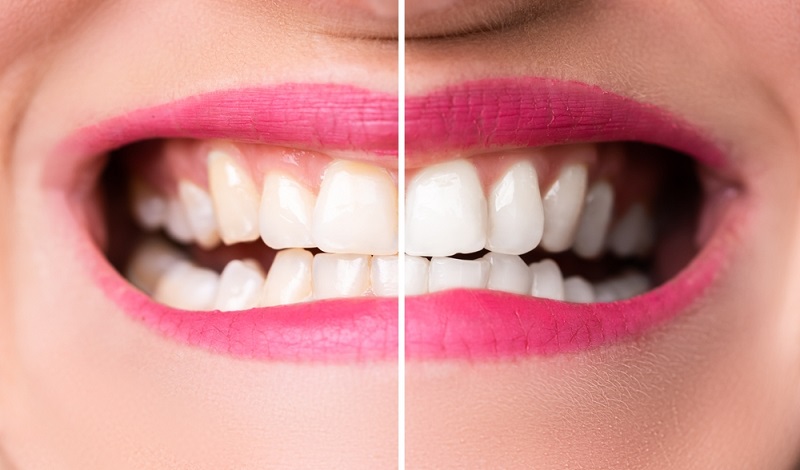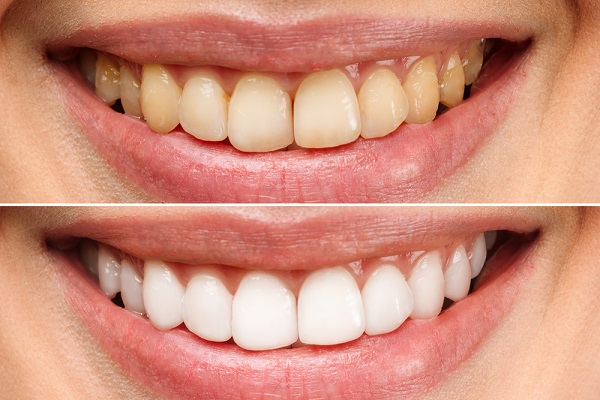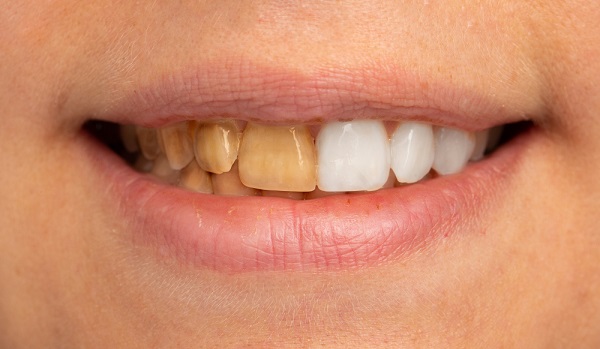Teeth Whitening Before and After Treatment Picture Results
Contents
- How Does Teeth Whitening Work?
- What are the Different Methods of Teeth Whitening?
- What Are Some Of The Chemicals Used for Teeth Whitening?
- Teeth Whitening Procedures Before And After
- What are Some Of The Ways I Can Whiten My Teeth At Home?
- 1. Baking soda and hydrogen peroxide:
- 2. Lemon juice:
- 3. Strawberries:
- 4. Commercial whitening products:
- Home Teeth Whitening Before and After Images
- Is Baking Soda A Good Option for Teeth Whitening?
- Baking Soda Teeth Whitening Before and After Picture
- Is Hydrogen Peroxide Good for Teeth Whitening?
- Hydrogen peroxide teeth whitening before and after Images
- How Smoking Stains Your Teeth?
- Conclusion
Have you ever wanted to have a smile worthy of Hollywood? The sort that enlightens the space and sparks wonder? You're not alone, after all.
One of the most often used cosmetic dental procedures today is teeth whitening. With all of its advantages—better oral health overall, a brighter smile, and increased self-confidence—why wouldn't it be?

But how can you choose the best teeth whitening procedure for you when there are so many options accessible today? We've got you covered, so don't worry!
We'll walk you through everything from before-and-after treatment results to various procedures that are available in our comprehensive guide to teeth whitening.
So take a seat back, unwind, and let's begin our trip with a brilliant white grin!
How Does Teeth Whitening Work?
Teeth whitening may function in a few distinct ways. Bleaching is the most popular technique since it employs strong chemicals to break up stains on your teeth and lighten them by several shades. This procedure, which can be carried out at home or in the dentist's office, typically lasts an hour.
Using whitening toothpaste, which has gentle abrasives to wipe away surface stains, is another well-liked technique. While it takes longer to see results with this procedure, bleaching is far more damaging to your teeth.
It's crucial to adhere to any directions given to you by your dentist or orthodontist for the greatest outcomes. This entails staying away from substances that can discolour your teeth as well as wearing a mouthguard when receiving expert whitening treatment.
What is the Teeth Whitening Procedure?
There are a few methods for teeth whitening that can be employed to get the desired results. Bleaching, which employs a chemical solution to remove stains and discolouration from the teeth, is the most widely used technique. A dentist can do this procedure at their clinic or at home using over-the-counter supplies.
Microabrasion is a different popular method of teeth whitening. This entails removing the tooth's top layer, which is frequently stained or discoloured, using a hand-held tool. Additionally, a dentist or a kit purchased over the market can perform this procedure at home.
One final option for teeth whitening is laser treatment. This method uses a concentrated beam of light to break down stains on the teeth. Laser treatment is usually done in a dentist’s office and typically takes one visit to achieve the desired results.
What are the Different Methods of Teeth Whitening?
The different methods of teeth whitening can be divided into two main categories: at-home teeth whitening and in-office teeth whitening.
1. At-Home Teeth Whitening:
At-home teeth whitening includes the use of whitening toothpaste, gels, strips, and trays is part of at-home teeth whitening.
These preparations frequently include bleaching ingredients like hydrogen peroxide or carbamide peroxide, which aid in removing surface-level stains and discolorations from the teeth.
2. In-office Teeth Whitening:
In-office teeth whitening, on the other hand, a dental professional in a dental office performs in-office teeth whitening.
This form of treatment can deliver more dramatic results in a shorter amount of time since it typically contains stronger bleaching agents than those found in at-home kits.
What Are Some Of The Chemicals Used for Teeth Whitening?
Different chemicals are used to whiten teeth, and each one has advantages and disadvantages of its own.
1. Hydrogen Peroxide:
One of the most widely used substances for tooth whitening is hydrogen peroxide. Numerous over-the-counter teeth whitening solutions contain it because it effectively whitens teeth. However, if used in high doses, it can also irritate the tongue and gums.
2. Carbamide Peroxide:
Carbamide peroxide is another widely used substance for teeth whitening is carbamide peroxide. Although it is less prone to aggravate hydrogen peroxide, it is less effective at teeth whitening. Professional teeth whitening procedures frequently use larger amounts of carbamide peroxide.
3. Stannous Fluoride:
Stannous fluoride is a chemical that is sometimes added to kinds of toothpaste and other oral care products for its ability to reduce plaque and tartar buildup on teeth.
However, stannous fluoride can also cause staining of the teeth if it is not used properly.
Teeth Whitening Procedures Before And After
We all want our teeth to look their best. And one of the quickest and easiest ways to improve the appearance of your smile is through teeth whitening.
But before you start any treatment, it’s important to know what to expect. Here are a few images of Teeth Whitening Procedures Before And After.
When it comes to teeth whitening, there are two main types of treatments: professional and at home. Professional teeth whitening is done by a dentist or other qualified healthcare professional. At-home teeth whitening uses bleaching kits that you can purchase over the counter or online.
Both types of treatments use bleaching agents to break up stains on your teeth. The main difference is the concentration of the bleaching agent. Professional treatments use higher concentrations, so they’re more effective at removing deep stains.
If you’re considering teeth whitening, it’s important to consult with your dentist first. They can help you decide if whitening is right for you and choose the best type of treatment based on your specific needs.
Before starting any treatment, it’s normal to feel some anxiety about how your teeth will look afterward. Will they be too white? Will the results last?
To help put your mind at ease, we’ve put together a collection of images of Teeth Whitening Procedures Before And After from real people who have undergone teeth whitening treatment.
These photos show a range of results, from subtle to dramatic. Depending on your unique circumstances, you can expect similar results from professional or at-home treatments.
By examining these photos and understanding what to expect, you can make an informed decision about which teeth whitening treatment is right for you.
Is Activated Charcoal Good For Teeth Whitening?
Whether you’re looking for an all-natural teeth whitening solution or you’re simply curious about the growing trend of activated charcoal kinds of toothpaste, it’s important to understand how this interesting ingredient works and what the potential risks are before using it on your pearly whites. Activated charcoal is a type of carbon that has been treated to increase its absorbency.
When used in teeth whitening products, it works by binding to stains on the surface of your teeth and absorbing them into the pores of the charcoal.
This can help to remove external stains caused by coffee, tea, wine, and smoking.
While activated charcoal is safe to use on your teeth, there are a few potential risks to be aware of.
- First, activated charcoal can be messy – be sure to wear old clothes or an apron while using it.
- Second, because it is abrasive, it can damage tooth enamel if used too frequently or vigorously. To avoid this, be sure to follow directions carefully and only use gentle circular motions when brushing with activated charcoal toothpaste.
- Finally, because it absorbs toxins and chemicals from your mouth, be sure to rinse your mouth thoroughly with water after using activated charcoal products.
If you’re looking for a safe and effective way to achieve brighter teeth, asking your dentist about professional teeth whitening treatments is always a good idea.
But if you’re interested in trying out activated charcoal as a natural alternative, just be sure to use it in moderation and practice good oral hygiene habits alongside other teeth-whitening solutions.
Activated Charcoal Teeth Whitening Before and After:
When it comes to teeth whitening, activated charcoal is one of the most popular methods. This natural remedy is said to remove stains and discolouration from teeth, revealing a brighter, whiter smile.
But does it work?
To find out, we talked to dental experts and looked at the latest research on activated charcoal teeth whitening.
Here’s what we found:
There is some evidence that activated charcoal can help remove stains from teeth. However, results vary and more research is needed to confirm its effectiveness.
If you do decide to try activated charcoal for teeth whitening, be sure to use it carefully. It can cause tooth enamel erosion and increase your risk for cavities if not used properly. Be sure to talk to your dentist before using activated charcoal on your teeth.
Now that you know more about activated charcoal teeth whitening, let’s take a look at some before and after photos. These images will give you an idea of what this treatment can do for your smile.

What are Some Of The Ways I Can Whiten My Teeth At Home?
There are several ways that you can whiten your teeth at home, including
1. Baking soda and hydrogen peroxide:
Mixing baking soda with hydrogen peroxide creates a paste that can be used to whiten teeth. Simply apply the paste to your teeth and brush as usual.
2. Lemon juice:
Lemons are rich in citric acid, which can help to remove stains from teeth. Apply lemon juice to your teeth using a cotton ball or Q-tip, and then rinse with water.
3. Strawberries:
Strawberries also contain citric acid, which can help to break down stained tooth enamel. Mash up a few strawberries and rub them onto your teeth for a few minutes before rinsing.
4. Commercial whitening products:
There are several commercial tooth-whitening products available that can be used at home, such as whitening strips or gels. Be sure to follow the instructions carefully when using these products.
Home Teeth Whitening Before and After Images
Before you start your teeth whitening journey and expect amazing home teeth whitening before and after results; it’s important to get an idea of what results you can expect.
That way, you can set realistic expectations for yourself and be more likely to be satisfied with your final results.
To give you a better understanding of the possibilities, we’ve put together a collection of before and after treatment photos.
These images showcase the kind of results that are achievable with different teeth whitening treatments.
As you look through the photos, keep in mind that everyone’s teeth are different. The results you achieve may not be identical to the ones shown here, but they can still be dramatic.
Is Baking Soda A Good Option for Teeth Whitening?
White teeth are often associated with youth and good oral hygiene. That’s why many people turn to teeth whitening treatments to achieve a brighter, whiter smile.
While there are many professional options available, some people prefer to use at-home remedies like baking soda.
Baking soda is an abrasive substance that can help remove surface stains from teeth. It’s also a popular home remedy for heartburn and indigestion.
When used for teeth whitening, baking soda can be mixed with water to create a paste. This paste can then be applied to the teeth using a toothbrush or your fingers.
There is some evidence to suggest that baking soda is effective at removing surface stains from teeth. However, it’s important to note that this home remedy can also damage the enamel on your teeth if used too frequently or harshly.
Baking soda should only be used once or twice a week as part of your regular oral care routine. If you experience any irritation or sensitivity after using this home remedy, discontinue use immediately and consult with your dentist.
Baking Soda Teeth Whitening Before and After Picture
When it comes to teeth whitening, people usually want to know two things: how well does it work, and what are the side effects? Unfortunately, there is no easy answer to either question.
It depends on a variety of factors, including the type of whitening treatment used, the individual's teeth, and the level of staining.
That said, some general trends can be observed in terms of before and after results. For instance, most people will see a significant difference in the shade of their teeth after undergoing professional treatment.

Over-the-counter products may also produce noticeable results, though these will typically be less dramatic.
As for side effects, the most common ones associated with teeth whitening are sensitivity and discomfort during the treatment itself. These should disappear soon after the procedure is over.
In very rare cases, people may experience more serious side effects like gum irritation or tooth damage.
However, these are usually only seen with very aggressive treatment methods or when instructions are not followed properly.
Is Hydrogen Peroxide Good for Teeth Whitening?
If you’re looking for an at-home teeth whitening solution that’s affordable and effective, you may be wondering if hydrogen peroxide is a good option.
Hydrogen peroxide is a bleaching agent that can remove stains from your teeth, making them look whiter and brighter.
When used correctly, hydrogen peroxide is safe for teeth whitening. However, it’s important to follow the instructions on the package to avoid any potential side effects, such as tooth sensitivity or gum irritation.
If you’re considering using hydrogen peroxide for teeth whitening, be sure to talk to your dentist first. They can help you determine if this treatment is right for you and provide guidance on how to use it safely and effectively.
Hydrogen peroxide teeth whitening before and after Images
When it comes to teeth whitening, one of the most popular methods is using hydrogen peroxide. This is because it’s relatively affordable and easy to find, plus it can be used in a variety of ways.
Whether you use it as toothpaste, mouthwash, or gel, hydrogen peroxide can help to remove surface stains and make your teeth look brighter.
To see the best results from using hydrogen peroxide for teeth whitening, it’s important to follow the instructions carefully.
For example, when using a hydrogen peroxide gel, you should only leave it on your teeth for the amount of time specified by the manufacturer. If you leave it on for too long, it could damage your tooth enamel.
When used correctly, hydrogen peroxide can have amazing results. Take a look at these before and after photos of people who have used this method to achieve whiter teeth.

As you can see, there’s a significant difference between the two sets of teeth!
How Smoking Stains Your Teeth?
When it comes to teeth, smoking is one of the worst things you can do. Not only does it cause bad breath and tooth decay, but it also leaves behind unsightly yellow and brown stains.
Over time, these stains can become permanent if they're not treated properly.
There are a few things you can do to remove smoking stains from your teeth. First, try brushing your teeth with whitening toothpaste.
If that doesn't work, you can try bleaching your teeth with a professional whitening kit.
You should also avoid foods and drinks that will stain your teeth, like coffee and red wine. Finally, quit smoking! It's the best way to keep your teeth healthy and white.
Before Treatment:
As we mentioned, smoking will stain your teeth over time. This discolouration can make it difficult to get your teeth as white as you want them with at-home treatments.
Many over-the-counter teeth whitening kits come with a disclaimer that they may not work as well for smokers.
If you’re set on using an at-home treatment, your best bet is to consult with your dentist first to see if it’s likely to be effective in your case.
After Treatment:
Even if you’re able to successfully whiten your teeth at home, smoking can quickly undo all your hard work.
That’s because the nicotine and tar in cigarettes will continue to cause staining, making your teeth look yellow or brown again within a few weeks or months.
If you want to keep your teeth looking their best, quitting smoking is the best way to do it.
Images of smokers' teeth before and after Teeth whitening
If you’re a smoker, you know that the nicotine and tar in cigarettes can lead to stained teeth.
But did you know that smoking also reduces the effectiveness of at-home teeth whitening treatments?
If you’re considering teeth whitening, it’s important to be aware of the potential consequences of smoking both before and after treatment.

Conclusion
Teeth whitening is an extremely effective way to improve your aesthetic appearance and boost your confidence.
We hope that you now have a better understanding of teeth whitening techniques and the potential results they can bring.
Follow our teeth whitening tips, consult with your dentist, and decide which teeth whitening treatment would be most suitable for you.
With dedication and commitment, there's no reason why you cannot achieve a brighter smile!


